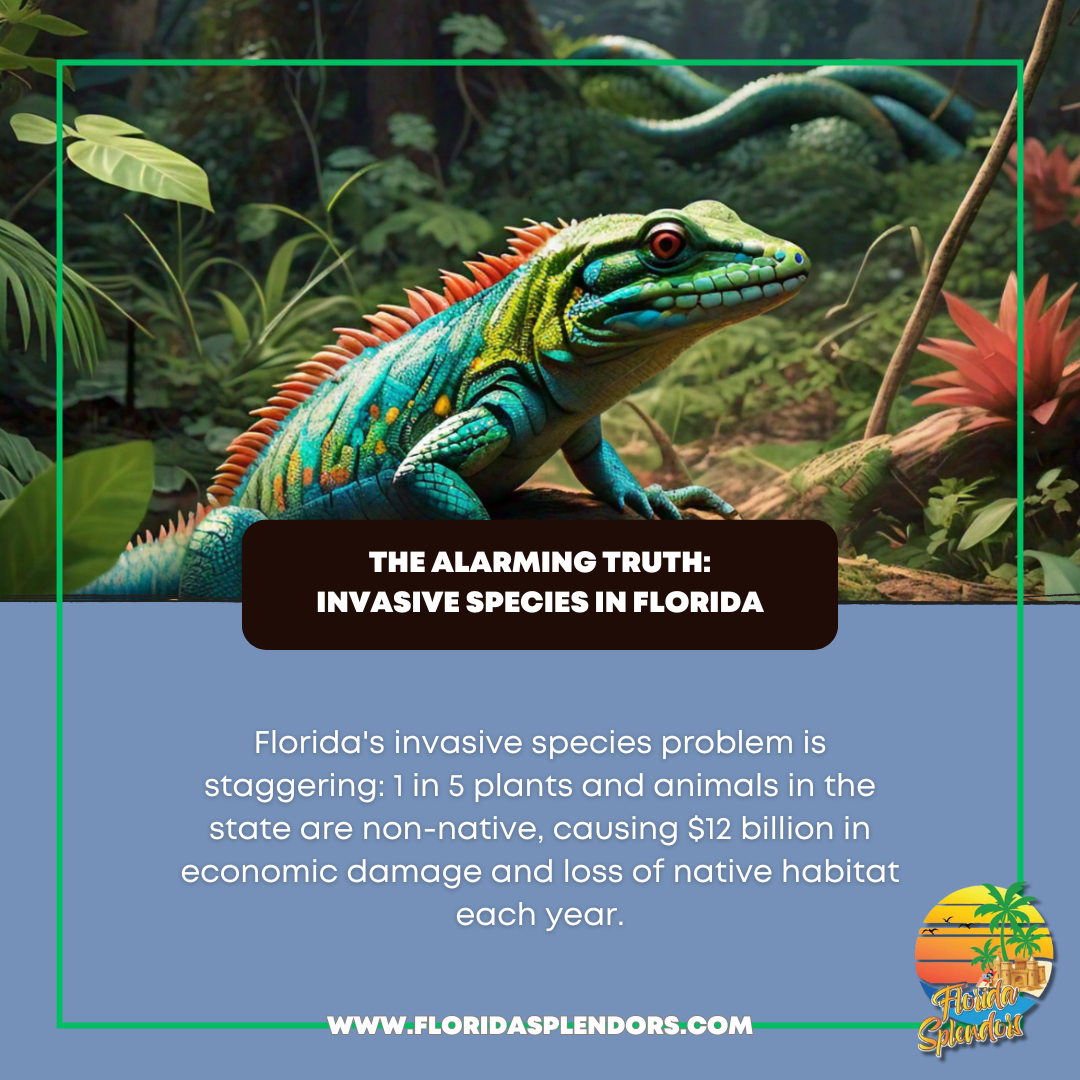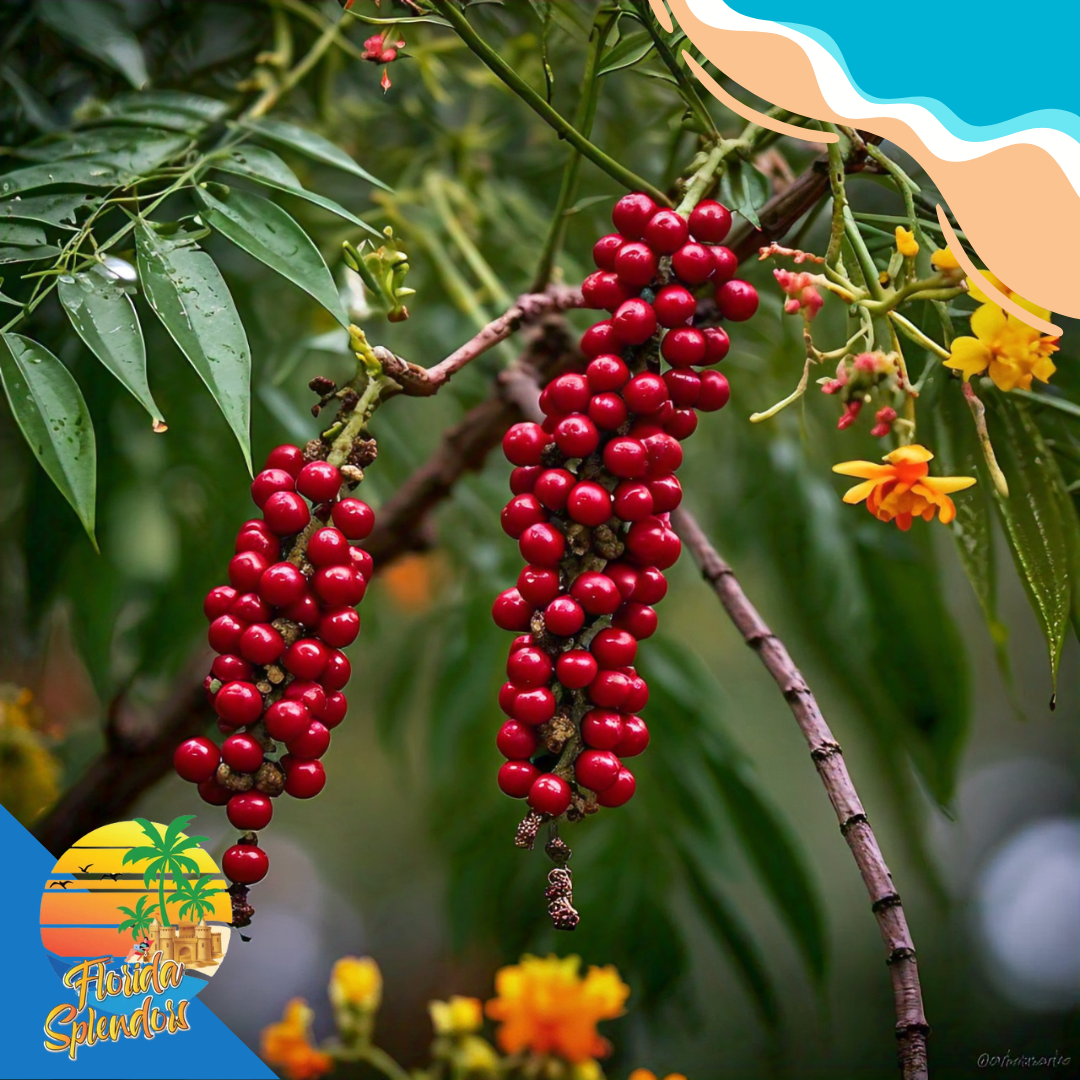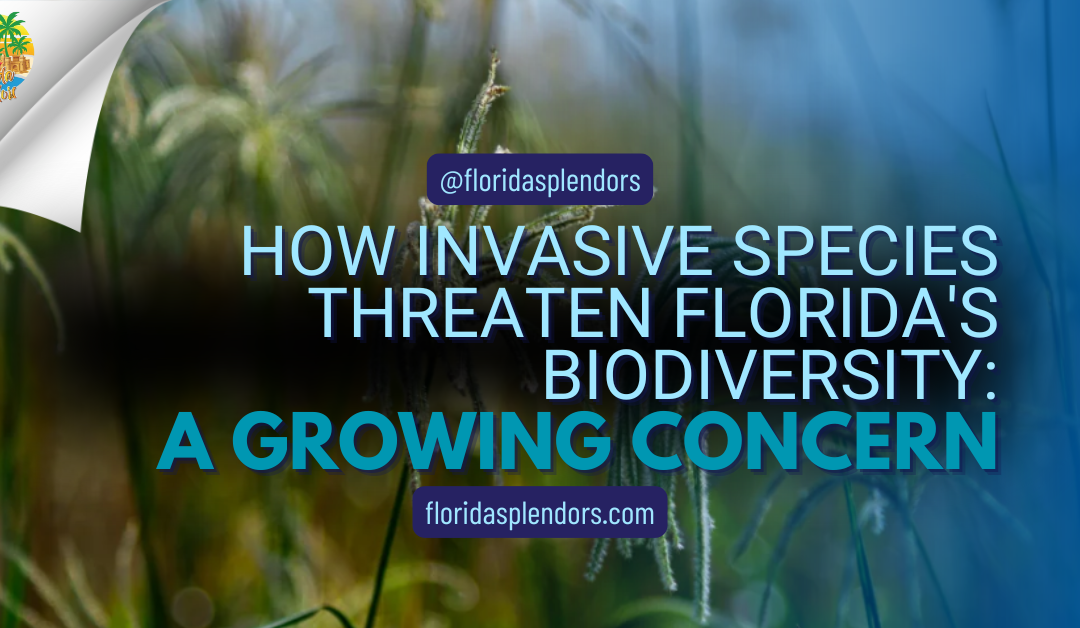==================
Florida Splendors is supported by our audience. When you purchase through one of our links, we may earn a small affiliate commission. As an Amazon Associate I earn from qualifying purchases. Your cost is not affected.
Ever wonder how invasive species are impacting Florida’s wildlife? It’s becoming a big issue! These non-native plants and animals are spreading fast, and they’re starting to crowd out the local species that make Florida so unique. From the Everglades to our beaches, invasive species are threatening the delicate balance of our ecosystems. Let’s dive into why this is such a growing concern and what we can do to protect Florida’s incredible biodiversity.
How Invasive Species Threaten Florida’s Biodiversity: A Growing Concern for the Sunshine State’s Ecosystems
Florida’s unique ecosystems face a growing threat from invasive species. These non-native plants and animals can quickly take over habitats, pushing out local wildlife and changing the landscape. From Burmese pythons in the Everglades to Brazilian pepper trees along the coasts, these invaders are causing big problems.

Invasive species cost Florida an estimated $100 million each year just to manage problematic plants, with animal control likely adding much more to that bill. This money goes towards removing harmful species and trying to protect native plants and animals. It’s a constant battle to keep Florida’s special natural areas safe from these unwanted guests.
The good news is that scientists and conservation groups are working hard to find solutions. They’re coming up with new ways to spot potential invaders early and stop them from spreading. By working together, Floridians can help protect their state’s amazing wildlife and beautiful landscapes for future generations to enjoy.

Key Takeaways
- Invasive species threaten Florida’s native plants and animals
- Managing invasive species costs Florida millions of dollars yearly
- Early detection and prevention are key to protecting Florida’s biodiversity

Understanding Invasive Species

Invasive species pose a major threat to Florida’s unique ecosystems. These non-native plants and animals can disrupt natural habitats and harm native wildlife.
Defining Invasive Species
Invasive species are plants, animals, or other organisms that are not native to an area and cause harm. They often spread quickly and take over ecosystems. In Florida, invasive species come from other parts of the world.
Many invasive species arrive by accident. Some hitchhike on ships or in packing materials. Others escape from farms or gardens. A few are released on purpose. Invasive species thrive because they lack natural predators in their new home. They can outcompete native plants and animals for food and space.
Impact on Florida’s Ecosystems
Florida’s warm climate and diverse habitats make it prone to invasions. Invasive species threaten biodiversity in the state’s unique ecosystems.
Some effects of invasive species include:
- Crowding out native plants
- Preying on native animals
- Altering food webs
- Changing fire patterns
- Damaging infrastructure
Invasive aquatic plants can clog waterways. This harms fish and makes boating difficult. On land, invasive plants can fuel more intense wildfires.
Case Studies: Notorious Invaders
Burmese pythons are one of Florida’s most famous invaders. These giant snakes eat native animals in the Everglades. They’ve caused a big drop in mammal populations. The melaleuca tree is another problem plant. It forms dense stands that crowd out other vegetation. Melaleuca trees also use lots of water, drying out wetlands.
In Florida’s waters, zebra mussels cause trouble. They cling to boats and clog pipes. Zebra mussels also filter out food that native species need. Red swamp crayfish burrow into banks, damaging levees. They also compete with native crayfish for food and shelter.
Biodiversity in Florida

Florida’s ecosystems are home to a rich variety of plants and animals. The state’s unique mix of tropical and temperate climates creates habitats for many rare species.
The Value of Diverse Ecosystems
Florida’s biodiversity provides many benefits. The state has over 4,000 native plant species and hundreds of native animals. These species play key roles in keeping ecosystems healthy. Mangrove forests protect coasts from storms and erosion. They also serve as nurseries for fish. Coral reefs attract tourists and shelter sea life.
Florida’s unique ecosystems support the economy too. Fishing, farming, and outdoor recreation rely on healthy natural areas. Plants and animals provide food, medicine, and materials. Diverse ecosystems are more resistant to threats like climate change. They recover faster from hurricanes and droughts.
Threatened Native Species
Many of Florida’s native species face risks. Development destroys habitats. Pollution harms animals and plants. Climate change alters environments faster than some species can adapt.
The Florida panther is one of the most endangered animals in the U.S. Only about 120-230 adults remain in the wild. Sea turtles struggle with beach erosion and light pollution.
Invasive species crowd out native plants and animals. Burmese pythons in the Everglades eat native wildlife. Brazilian pepper trees take over natural areas Conservation efforts aim to protect threatened species. Restoring habitats and controlling invasives can help. But many species still risk extinction without more action.
Challenges in Management

Managing invasive species in Florida is complex. It requires quick action, strong prevention, and teamwork between groups. These efforts face many hurdles.
Early Detection and Rapid Response
Spotting new invasive species early is key. Florida’s warm climate makes it easy for many species to spread fast. Teams must check often for new threats. The state uses a national framework for early detection and rapid response. This helps them act quickly when they find new invaders. But it’s hard to check every area all the time.
Experts train to spot new species. They use special tools to find and track invaders. Still, some may slip through unnoticed.
Prevention and Biosecurity Measures
Stopping invasives before they arrive is crucial. Florida has strict rules about bringing in plants and animals. Ports and airports have checkpoints to catch banned species. But not all entry points can be watched all the time. Some invaders come in by accident, hidden in shipments or on boats.
Public education is vital. People need to know not to release pets or plants into the wild. Signs at boat ramps remind boaters to clean their boats to avoid spreading aquatic weeds.
Collaborative Efforts Across Organizations
Fighting invasives takes teamwork. The University of Florida, state agencies, and local groups all play a part. They share info and resources to tackle the problem.
The Florida Fish and Wildlife Conservation Commission leads many efforts. They work with federal partners like the Department of Interior. Together, they create plans to manage invasive species. Coordinating all these groups can be tricky. Each may have different goals or methods. Funding can also be a challenge, as managing invasives is costly.
Conservation and Restoration Efforts

Florida is taking action to protect its native species and habitats. Groups are working to fix damaged areas and teach people about the problem.
Habitat Restoration Initiatives
The Everglades restoration project is a big part of saving Florida’s ecosystems. Teams are removing invasive plants and animals to help native species thrive. They’re also working on improving water quality. This helps both wildlife and people who depend on clean water.
Some groups use biological control. They bring in natural enemies of invasive species to keep them in check. This method needs careful planning to avoid new problems.
Public Awareness and Education
Teaching people about invasive species is key. Many groups run programs to help folks spot and report invasive plants and animals. Schools are including lessons about local ecosystems. Kids learn why native species matter and how to protect them.
Community events let people help with restoration work. This hands-on experience builds a connection to nature. Social media campaigns spread the word about invasive species. They show how these creatures affect daily life, from fishing to gardening.
Effect on Human Activities

Invasive species in Florida cause major problems for people. They harm farms, fishing, and daily life. They also create health risks and damage buildings and roads.
Agriculture and Fisheries
Invasive plants and animals hurt Florida’s farms and fishing industry. Exotic weeds crowd out crops and make it hard to grow food. For example, cogongrass spreads quickly and takes over farmland. It’s very hard to get rid of. Invasive insects also damage crops. They eat plants and spread diseases. This costs farmers a lot of money.
In the water, invasive fish hurt local species. This makes it harder for fishers to catch the fish people want to eat. Some invaders, like lionfish, even harm coral reefs. This affects tourism and fishing jobs.
Impacts on Health and Infrastructure
Some invasive species in Florida can make people sick. For instance, certain mosquitoes spread diseases. They can give people viruses like Zika or dengue fever. Invasive plants also cause problems. Some make allergies worse. Others, like Brazilian pepper, can give people rashes if they touch them.
These species damage buildings and roads too. Invasive termites eat wooden structures. Some plants grow so fast they crack sidewalks and foundations. This costs a lot to fix. Cleaning up invasive species is expensive. Florida spends $100 million each year just to manage invasive plants. This money could be used for other things to help people.
The Path Forward

Florida faces big challenges from invasive species. New plans focus on spotting threats early and changing laws to limit their spread.
Strategies for Risk Assessment
Scientists use a method called horizon scanning to find potential invasive species. They look at which plants and animals might come to Florida and cause harm. Experts check how likely a species is to arrive and spread. They also look at possible impacts on nature, the economy, and people’s health.
This helps them rank threats. For example, a recent study found 40 species that pose the biggest risk to Florida.
Legislation and Trade Policies
Florida is working on new laws to stop invasive species. These rules aim to control the pet trade, especially for reptiles. Stricter rules on buying and selling exotic pets can help. They make it harder for dangerous animals to escape into the wild.
The state also wants to change how plants are brought in. This could stop harmful weeds from spreading. Better policies can save money too. Right now, Florida spends about $100 million each year just to manage invasive plants.

Fun Fact
Did you know that invasive species can spread at an astonishing pace? Many of these species reproduce rapidly, often producing large numbers of offspring in short periods, allowing them to quickly establish dominance in new environments. Their ability to adapt to various conditions and lack of natural predators gives them an advantage, enabling them to cover vast areas. This rapid spread often overwhelms native species, competing for resources like food, water, and habitat, and can lead to significant disruptions in local ecosystems, threatening biodiversity and even altering entire landscapes.
A Growing Concern: Invasive Species in Florida
Invasive species pose a significant and growing threat to Florida’s rich biodiversity, disrupting ecosystems and outcompeting native wildlife. As these non-native species spread rapidly, they create long-term challenges for conservation efforts and the health of our natural environments. Addressing this issue requires collective action—from raising awareness to supporting conservation programs that protect our native species and preserve Florida’s unique ecosystems. By staying informed and involved, we can help safeguard the state’s natural beauty for generations to come.

Join the fight against invasive species in Florida! Share your knowledge and experiences to raise awareness and promote prevention. Let’s work together to protect our state’s ecosystems and biodiversity.
Frequently Asked Questions

Invasive species pose a significant threat to Florida’s ecosystems. These non-native plants and animals cause harm to native species and habitats. Let’s explore some key questions about invasive species in Florida.
What's Inside
- What are the top invasive species currently impacting the Florida Everglades?
- How are invasive plants altering Florida's native ecosystems?
- Why is Florida experiencing a high number of invasive species?
- Can you list some strategies being employed to manage invasive species in Florida?
- What effects do non-native reptiles have on Florida's biodiversity?
- Which invasive species in Florida offers a bounty program for their capture or removal?
What are the top invasive species currently impacting the Florida Everglades?
The Florida Everglades face threats from several invasive species. Burmese pythons are one of the most well-known invaders. These large snakes eat native wildlife and disrupt the food chain.
Brazilian pepper trees also cause problems in the Everglades. They form dense thickets that crowd out native plants. Melaleuca trees are another major concern, as they spread quickly and alter water flow.
How are invasive plants altering Florida's native ecosystems?
Invasive plants change Florida’s landscapes in many ways. They often grow faster than native species and take over large areas. This crowds out native plants and reduces biodiversity.
Some invasive plants, like cogongrass, can even change fire patterns. They burn hotter and more frequently than native grasses. This can harm animals and plants that aren’t adapted to frequent fires.
Why is Florida experiencing a high number of invasive species?
Florida’s warm climate makes it easy for many non-native species to thrive. The state’s busy ports and airports allow new species to enter accidentally. Pet releases and plant escapes from gardens also contribute to the problem.
Florida’s many lakes, rivers, and wetlands provide homes for aquatic invaders. The state’s location makes it a gateway for species from the Caribbean and South America.
Can you list some strategies being employed to manage invasive species in Florida?
Florida uses various methods to control invasive species. Biological control involves introducing natural predators or diseases from the invasive species’ home range.
Chemical control uses herbicides or pesticides to kill invasive plants and animals. Mechanical removal involves physically cutting down or pulling out invasive plants. Public education helps prevent new introductions and encourages early detection.
What effects do non-native reptiles have on Florida's biodiversity?
Non-native reptiles eat native animals and compete for food and habitat. Burmese pythons, for example, have decimated small mammal populations in the Everglades. Green iguanas damage native plants and infrastructure. Argentine tegus is another concern. These large lizards eat the eggs of native turtles and alligators. They also compete with native species for food and shelter.
Which invasive species in Florida offers a bounty program for their capture or removal?
Florida has a bounty program for Burmese pythons. Hunters can earn money for catching these snakes in the Everglades. The program aims to reduce python numbers and protect native wildlife.
Lionfish are another species with removal incentives. Divers and fishers are encouraged to catch these invasive fish. Some areas even hold lionfish removal competitions to help control their numbers.
Excited to Explore Florida’s Best-Kept Secrets?
Join the Florida Splendors community and dive into a world of adventure and discovery! Uncover hidden gems, connect with fellow adventurers, and share your passion for the Sunshine State. Whether you’re paddling through tranquil waters, soaking up the sun on picture-perfect beaches, or exploring Florida’s lively cities, we’ve got all the inspiration you need for a memorable journey.
Follow us on:
Let’s embark on Florida’s greatest adventures together!

